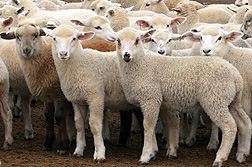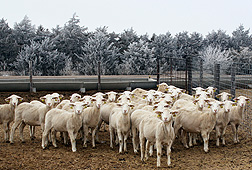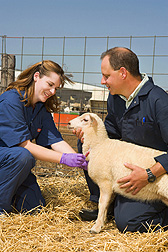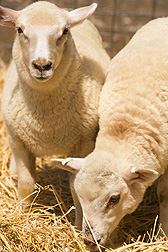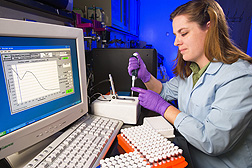Viral Infection in Sheep Linked to Gene
The discovery of a gene associated with a persistent viral infection that causes an incurable disease—ovine progressive pneumonia (OPP)—in sheep has led to the development of a genetic test that can be used to help reduce the impact of the disease.
A slow-acting, wasting disease, OPP affects millions of sheep worldwide and is one of the most costly diseases to producers in North America. Previous research revealed that 36 percent of sheep operations and 24 percent of sheep tested in the United States were infected with ovine progressive pneumonia virus (OPPV)—lentivirus strains that target the immune system and cause OPP.
Once infected, sheep are infected for life. Infected ewes are about 20 percent less productive, having fewer lambs and that also weigh less than lambs born to uninfected ewes. In addition to pneumonia, they show signs of wasting, lameness, and “hard bag” syndrome, in which udders become hard and contain barely any milk. Infected ewes are often culled—removed from the flock.
Scientists at the Agricultural Research Service Roman L. Hruska U.S. Meat Animal Research Center (USMARC) in Clay Center, Nebraska, along with their colleagues at the Animal Disease Research Unit in Pullman, Washington, and the U.S. Sheep Experiment Station near Dubois, Idaho, have found and verified that the gene—TMEM154—affects susceptibility to OPPV infection in sheep.
A Journey to Discovery
Research to find a genetic link began in the late 1990s, when scientists recognized that the rate of OPPV infection varied among breeds of sheep in the same flocks at USMARC.
“In one breed, 80 percent of the animals were infected, whereas in another breed, 15 percent were infected,” says microbiologist Michael Heaton, who’s in USMARC’s Genetics, Breeding, and Animal Health Research Unit. “They were being raised together, but the proportion that got infected was different for each breed.”
This finding suggested that breed made a difference and that genetics were a major factor in the susceptibility of sheep to OPPV, Heaton says. The team began studies of the USMARC flock, testing the sheep for candidate genes that could be involved in infection.
After 10 years of research, scientists were finally able to design a genome-wide study, thanks to the development of the Ovine SNP50 BeadChip by the International Sheep Genome Consortium. The researchers genotyped animals using blood samples collected over the years and discovered a gene, TMEM154, that influences OPPV infection. They also found several different forms, or “haplotypes,” of the gene. Although the function of this gene is still unknown, the three major forms—haplotypes 1, 2, and 3—were found in 97 percent of the more than 8,000 sheep tested.
|
|
Gene Type Matters
“Sheep in the United States typically have some combination of these three major forms of the TMEM154 gene,” Heaton says. “Each animal will have two haplotypes—one inherited from its mother and one from its father.”
Haplotypes 2 and 3 were strongly associated with OPPV infection and considered to be highly susceptible forms of TMEM154. Only one copy of either haplotype 2 or 3 was needed to increase the risk for OPPV infection. In contrast, ewes with two copies of haplotype 1 were significantly less likely to be infected.
“Rams that have two copies of haplotypes 2 or 3 clearly carry the most risk,” Heaton says. “If you are selecting rams within your flock or buying new rams, you might want to avoid those. But our research indicates that rams with two copies of haplotype 1 seem to provide an advantage.”
Although these results are promising, OPPV is highly adaptable and affects flocks differently, Heaton adds. It is uncertain whether selection for TMEM154 haplotype 1 will reduce the incidence of infection in all production environments.
“We are now conducting research to learn more about these three most common forms of the gene—which ones are less susceptible, which ones are more susceptible, and if one form of the gene is dominant relative to other forms of the gene,” says USMARC geneticist Kreg Leymaster.
|
|
Testing for Risks
With these findings, scientists were able to develop a genotyping test in collaboration with GeneSeek, a Neogen Corporation Company based in Lincoln, Nebraska. The test, which is now available for commercial use, indicates which sheep have the highest genetic risk for becoming infected if exposed to the virus.
Diagnostic tests have been available for some time to determine whether sheep are infected with OPPV, Leymaster says. “But they don’t tell us whether a sheep is more or less susceptible to the disease. What our test has done is add a genetic component that previously wasn’t available.”
For example, a producer can make a flock free of the disease by eliminating infected sheep, but that doesn’t mean that the flock would be resistant to the disease if an infected animal were brought in, he adds.
“Producers could use the marker we’ve made available to make a flock genetically less susceptible to disease, and therefore, decrease the risk of animals becoming infected again over time,” Leymaster says.
|
|
The ultimate goal is to give producers tools that allow them to choose breeding stock that do not have genetic risk factors, he says, so they can reduce the prevalence of OPPV and eventually eradicate it from flocks.
What’s critical is that producers understand the incidence of the disease in their flock, Leymaster says. Not all flocks are infected. Producers can look at their own unique management system, take the information provided from this research, and decide whether it fits into their system.
Adverse production conditions like high animal density, indoor housing with poor ventilation, and moist climates may enhance virus transmission and overcome sheep genetic resistance, the scientists say.
“We don’t want to oversell these findings, but at the same time, we want producers to consider how they might use this to their advantage,” Leymaster says. “We’re continuing our research and will be able to contribute additional information in the future. I’m optimistic that the industry will be able to successfully address this major disease problem.”—By Sandra Avant, Agricultural Research Service Information Staff.
This research is part of Animal Health, an ARS national program (#103) described at www.nps.ars.usda.gov.
Michael Heaton and Kreg Leymaster are in the USDA-ARS Roman L. Hruska U.S. Meat Animal Research Center, State Spur 18D, Clay Center, NE 68933; (402) 762-4362 [Heaton], (402) 762-4172 [Leymaster].
"Viral Infection in Sheep Linked to Gene" was published in the May/June 2013 issue of Agricultural Research magazine.







